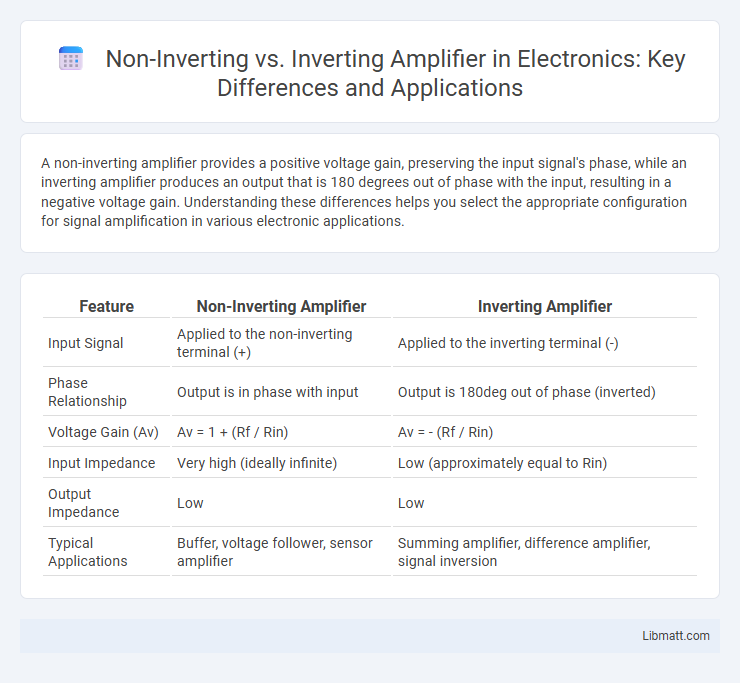A non-inverting amplifier provides a positive voltage gain, preserving the input signal's phase, while an inverting amplifier produces an output that is 180 degrees out of phase with the input, resulting in a negative voltage gain. Understanding these differences helps you select the appropriate configuration for signal amplification in various electronic applications.
Table of Comparison
| Feature | Non-Inverting Amplifier | Inverting Amplifier |
|---|---|---|
| Input Signal | Applied to the non-inverting terminal (+) | Applied to the inverting terminal (-) |
| Phase Relationship | Output is in phase with input | Output is 180deg out of phase (inverted) |
| Voltage Gain (Av) | Av = 1 + (Rf / Rin) | Av = - (Rf / Rin) |
| Input Impedance | Very high (ideally infinite) | Low (approximately equal to Rin) |
| Output Impedance | Low | Low |
| Typical Applications | Buffer, voltage follower, sensor amplifier | Summing amplifier, difference amplifier, signal inversion |
Introduction to Operational Amplifiers
Operational amplifiers (op-amps) are versatile electronic components used to amplify voltage signals, with two primary configurations: non-inverting and inverting amplifiers. The non-inverting amplifier provides a positive voltage gain where the input signal is applied to the non-inverting terminal, maintaining the signal's phase, while the inverting amplifier applies the input to the inverting terminal, producing an output that is 180 degrees out of phase. Understanding these configurations helps you design circuits tailored for specific signal amplification needs, optimizing performance and stability in electronic applications.
Overview of Inverting and Non-Inverting Amplifiers
Inverting amplifiers provide a phase-inverted output signal relative to the input, achieving high gain stability through feedback resistors and offering precise control over the amplification factor. Non-inverting amplifiers maintain the input signal phase while providing a high input impedance, making them ideal for impedance buffering and low signal distortion. Both amplifier configurations are fundamental for analog signal processing, with inverting amplifiers favoring applications needing phase reversal and gain accuracy, while non-inverting amplifiers excel in signal integrity and input sensitivity.
Circuit Configurations: Inverting vs Non-Inverting
Inverting amplifiers use a feedback resistor connected between the output and the inverting input, with the input signal applied to the inverting terminal, resulting in a 180-degree phase shift. Non-inverting amplifiers apply the input signal directly to the non-inverting input, with feedback provided to the inverting input, preserving the signal phase. The key difference lies in the input connections and phase output: inverting amplifiers invert the signal, while non-inverting amplifiers maintain the original polarity.
Voltage Gain Differences
Non-inverting amplifiers provide a voltage gain of 1 plus the ratio of feedback resistor to input resistor, resulting in gain values greater than or equal to one. Inverting amplifiers deliver voltage gain determined by the negative ratio of feedback resistor to input resistor, allowing for both amplification and phase inversion. Your choice between these amplifier types directly impacts signal phase and voltage gain magnitude in electronic circuit design.
Input and Output Impedance Comparison
Non-inverting amplifiers typically exhibit high input impedance, often ranging from megaohms to gigaohms, making them ideal for buffering signals without loading the source. In contrast, inverting amplifiers present lower input impedance, defined mainly by the input resistor value, which can affect the signal source. Your choice between these configurations depends on whether high input impedance for minimal signal loading or precise gain control with feedback is more critical for your application.
Phase Relationship of Output Signals
Non-inverting amplifiers maintain the same phase between input and output signals, meaning your output signal will be in phase with the input. In contrast, inverting amplifiers produce an output signal that is 180 degrees out of phase with the input, resulting in a phase inversion. Understanding this phase relationship is critical when designing circuits that require signal synchronization or feedback control.
Applications of Inverting Amplifiers
Inverting amplifiers are widely used in signal processing applications where phase inversion and precise gain control are required, such as audio mixing, active filters, and analog computation. They provide accurate summation and subtraction of input signals, making them essential in instrumentation and sensor interfacing. Your circuits benefit from their high input impedance and stability in feedback networks, ensuring reliable and noise-resistant performance.
Applications of Non-Inverting Amplifiers
Non-inverting amplifiers are widely used in signal conditioning where preserving the input signal's phase is critical, such as in audio equipment, sensor interfaces, and medical instrumentation. Their high input impedance makes them ideal for buffering voltage signals without loading the source, ensuring accurate amplification. Common applications also include active filters, voltage followers, and impedance converters in communication systems and precise measurement devices.
Advantages and Limitations
Non-inverting amplifiers offer high input impedance and preserve signal phase, making them ideal for voltage amplification without load signal distortion. Inverting amplifiers provide precise gain control and improved bandwidth but introduce phase inversion and lower input impedance, which may affect signal integrity. Your choice depends on the application requirements for signal phase, impedance matching, and gain stability.
Summary: Choosing the Right Amplifier Configuration
Non-inverting amplifiers provide a positive voltage gain with high input impedance, making them ideal for buffering and signal conditioning where signal integrity is crucial. Inverting amplifiers offer precise gain control with phase inversion, suitable for applications requiring signal summation or subtraction. Your choice depends on whether you need signal polarity preservation and input impedance considerations versus gain accuracy and phase requirements.
Non-inverting vs Inverting amplifier Infographic

 libmatt.com
libmatt.com